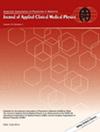Evaluation of the system accuracy of frameless stereotactic radiosurgery using a combination of cone beam CT, six degrees of freedom couch, and surface image-guided systems
Abstract
Purpose
This study aims to evaluate the accuracy of the frameless linear accelerator-based stereotactic radiosurgery (FSRS) system incorporating cone-beam CT (CBCT), six degrees of freedom (6-DoF) couch, room laser, and surface image-guided (SG) systems. It focuses on assessing the FSRS system's accuracy and ability to detect position errors using head phantoms at different couch angles. Turntables were used to simulate the couch rotation to overcome the limitation of the available couch rotation angles for a 360° CBCT scan.
Methods
Two head phantoms, each positioned on its respective turntable, were used for measurements, with the turntables placed on the couch. Factors affecting the evaluations of the FSRS system's accuracy were analyzed, including quality assurance (QA) procedures for the SG system, the automatic CBCT-CT registration method, the CBCT clip box volume, and the selected region of interest (ROI) size in the SG system. Discrepancies in isocenter shifts between CBCT and SG systems were measured to evaluate the FSRS system's accuracy and its ability to correct isocenter shifts at different turntable angles. The FSRS system's ability to detect position errors at different turntable angles was also evaluated by introducing ± 2.0 mm translational errors.
Results
With the appropriate CBCT-CT registration method and ROI size of the SG system, the accuracy evaluations of the FSRS system indicated average discrepancies between the readouts from the CBCT and the SG system ≤ 0.9 mm/0.8° for the head phantoms. Error simulation demonstrated that the FSRS system was able to detect position errors when 2 mm translational errors were intentionally introduced, with most average discrepancies < 1 mm/1°.
Conclusion
This study introduces an innovative approach to quantifying the impact of couch rotation on the FSRS system using head phantoms with turntables. The overall accuracy of the FSRS system was on the order of 1.1 mm/1°.

 求助内容:
求助内容: 应助结果提醒方式:
应助结果提醒方式:


